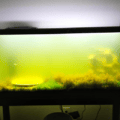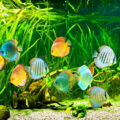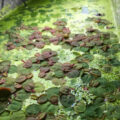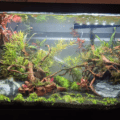A detailed description and care guide for beginner-friendly platy variants to use as aquarium starters, including picture references for easy identification!
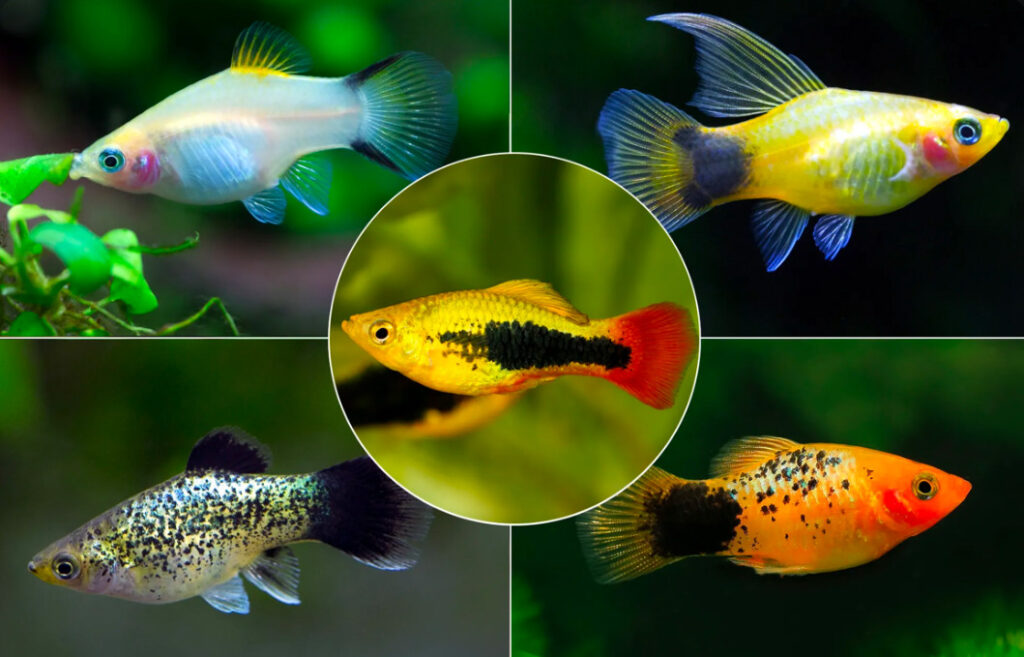
Why Platies Are Great for Beginners
If you’re a beginner looking for a hardy aquarium fish to add to your tank, the freshwater platy species is a great choice. It’s a resilient, colorful, and peaceful small fish that thrives in community setups.
Because it’s a peaceful livebearer, you can easily breed your platy in a home tank and manage its lifestyle as it matures. This species isn’t fussy with food and comes in a variety of colors.
You can choose one or more of these 13 types of platy fish to design a species-only tank with a diverse community. In this platy fish beginner guide, you’ll learn about some popular and rare varieties, including their care tips, starting with the Mickey Mouse Platy.
Author’s Note: Check out our post Are Platies Good Beginner Fish for a comprehensive discussion on this topic!
Mickey Mouse Platy Overview

Yes, the Mickey Mouse platy has the signature black round ears and head shape, but not the way you imagine. This black mark appears on the base of this fish’s body just above its tail.
The rest of this iconic aquarium fish’s body is reddish-orange with a large silver spot on the lower half of its upper body. This striking appearance makes this colorful platy fish a conversation starter in any aquarium.
Here’s a platy fish beginner’s guide for proper management.
Mickey Mouse Platy Care Guide
Platies are livebearers, which means their young don’t go through the egg/larva stage before maturity. That also means as a species, this beginner livebearer is sensitive to environmental factors.
Get a tank size of at least 10 gallons per single Mickey Mouse platy and set the following water parameters:
- Temperature: 64 – 77°F
- pH: 7.0 – 8.2
- Hardness: 10 – 20 dGH
Mickey Mouse Platies eat all food types since they’re omnivores. Feed them live, frozen, dried, and plant-based foods.
Sunset Platy Overview
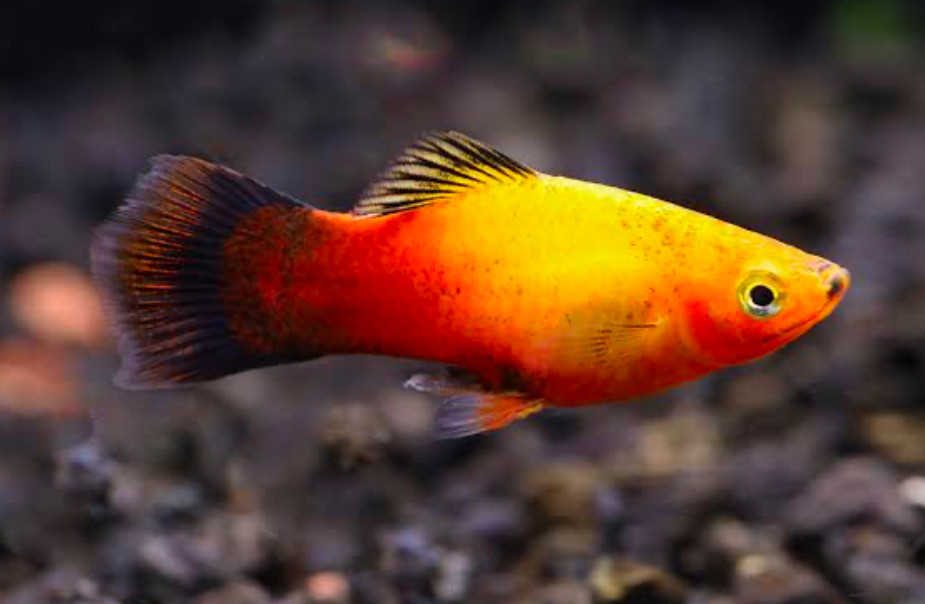
For a sunny, orange-to-gold morph that can brighten your tank, choose the Sunset Platy fish. Besides being a colorful aquarium fish, this variety is also popular for its calm and friendly nature. So it’s another beginner’s favorite for community keeping.
Sunset Platies come in a wide array of sunny colors from pure gold to golden-yellow, yellow/red/black, and orange. Although small, with an average size of 3-5 inches, this sometimes orange platy requires room to swim.
Sunset Platy Care Guide
With the proper care, your sunset gold platy can live up to 5 years in the aquarium. Get a tank that’s approximately 35 to 40 gallons in width for a small group of four and establish stable water parameters.
- Temperature: 64 – 80°F
- pH: 7.0 – 8.0
- Hardness: 10 – 25 dGH
Feed your glowing sunset platy with high-quality commercial flakes and supplement its diet with live foods like bloodworms and brine shrimp. For a diverse community tank, add plecos, danios, and gouramis to the mix.
Red Wagtail Platy Overview
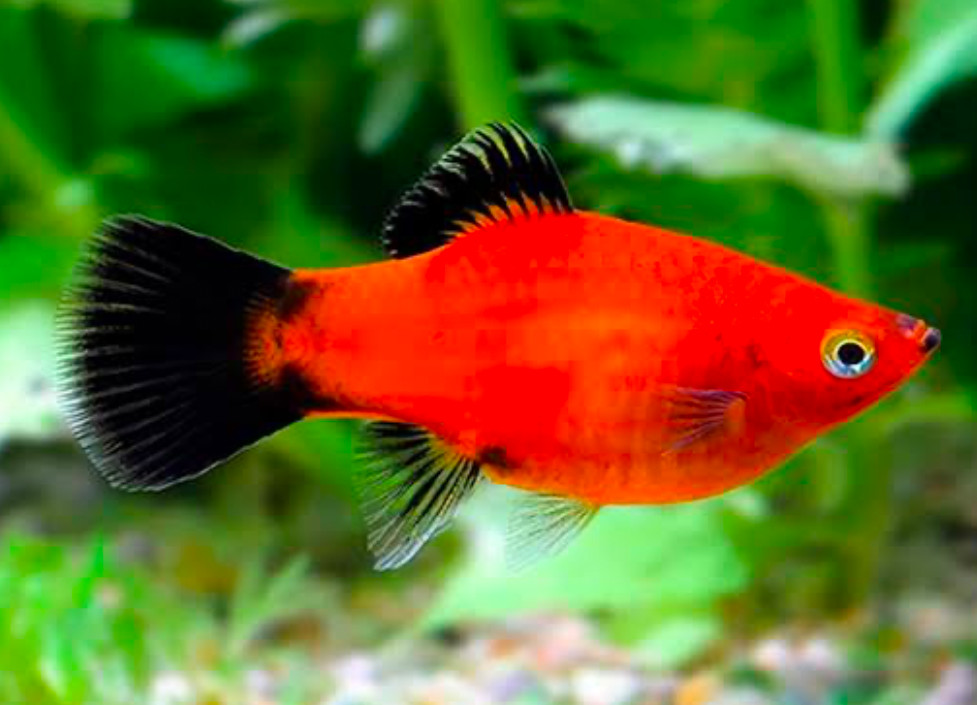
If you like a smoky-looking fish with a fiery body, the red wagtail platy is a suitable choice. This platy variety has a bright red body with black caudal and tail fins that stand out in any tank aesthetic.
This red-black platy is an engaging variety to own due to its active swimming nature, making it visually stimulating to watch.
You’ll need a long tank with enough swimming area and top-notch care routines for this vibrant red fish to thrive.
Red Wagtail Platy Care Guide
Set the following water conditions for this hardy livebearer:
- Temperature: 70 – 82°F
- pH: 7.0 – 8.0
- Hardness: 10 – 28 dGH
Fill your tank with dense live vegetation that’ll be hiding spots for the free-swimming fry, which’ll grow into mature adult Platies.
Your red wagtail platy is also compatible with danios and peaceful plecos, and it’ll survive on a varied diet of animal-based and plant-based food like mosquito larvae, brine shrimp, zucchini, and algae.
Blue Coral Platy Overview

Moving on from warm tones, let’s look at a blue platyfish that brings coolness to your tank. The coral platy has a striking blue body with different shades and faint black patterning.
Some coral platies include orange tints, silver hues, or even dotted calico spots. This colorful freshwater fish is one of the smaller varieties, as its maximum size in maturity is between 2-2.5 inches.
Aquarists with modern aquascapes in their nano and small tanks often go for this variety.
Blue Coral Platy Care Guide
Here’s a guide on how you can maintain this tropical freshwater beauty in a personal tank. Get a rectangular tank that holds at least 5 to 10 gallons of water for a single coral platy fish. Add live plants, such as Java moss and anubias, to the aquascape as a shelter for your pets and set the ideal water conditions in the tank.
- Temperature: 72 – 80°F
- pH: 6.5 – 8.0
- Hardness: 10 – 28 dGH
Coral Platies eat mostly plant-based foods but also enjoy high-quality flakes and some live or frozen foods as supplements.
With proper care, this peaceful livebearer will live for 2 to 3 years.
Tuxedo Platy Overview

Platies are normally common, but with these two-tone platy fish, you can add an aura of exoticness to your tank.
The Tuxedo Platy is a hardy freshwater variant that has a color pattern resembling a tuxedo jacket. Its two-toned scales are often a deep shade of black with another color, such as red, orange, golden yellow, or translucent white, on the fins and tails.
With bold colors like this and an active personality, it’s no wonder the tuxedo platy is one of the more popular beginner fish types.
Tuxedo Platy Care Guide

To properly care for this colorful livebearer in a tank, you must provide it with an optimal diet and living conditions.
Feed your tuxedo platy with an omnivorous diet, pair it with other peaceful livebearers like Mollies and Guppies, and set the following water conditions:
- Temperature: 70 – 80°F
- pH: 7.0 – 8.0
- Hardness: 10 – 25 dGH
Ensure you keep your tuxedo platy in a group of at least five to appeal to its friendly, schooling nature.
Panda Platy Overview

Another beautiful, beginner-friendly two-toned variety is the Panda Platy fish. It has a white body with black patches on its lower body and tail, and a blush pink-tinted line beneath its eye. This small, peaceful, and easy-to-maintain black-white fish is a great choice for beginner aquarists with minimalist or monochrome-themed tanks.
Panda Platy Care Guide
You can take care of this calm, freshwater, small fish by providing a tank that’s at least 15 gallons wide, setting ideal water conditions:
- Temperature: 75 – 82°F
- pH: 7.0 – 8.0
- Hardness: 10 – 25 dGH
Keep the water filtered and maintain a group of 5-6 to ensure your peaceful livebearer stays happy and engaged. Also, feed your panda platy with love and a plant-based diet for a strong immune system and proper development.
Gold Platy Overview
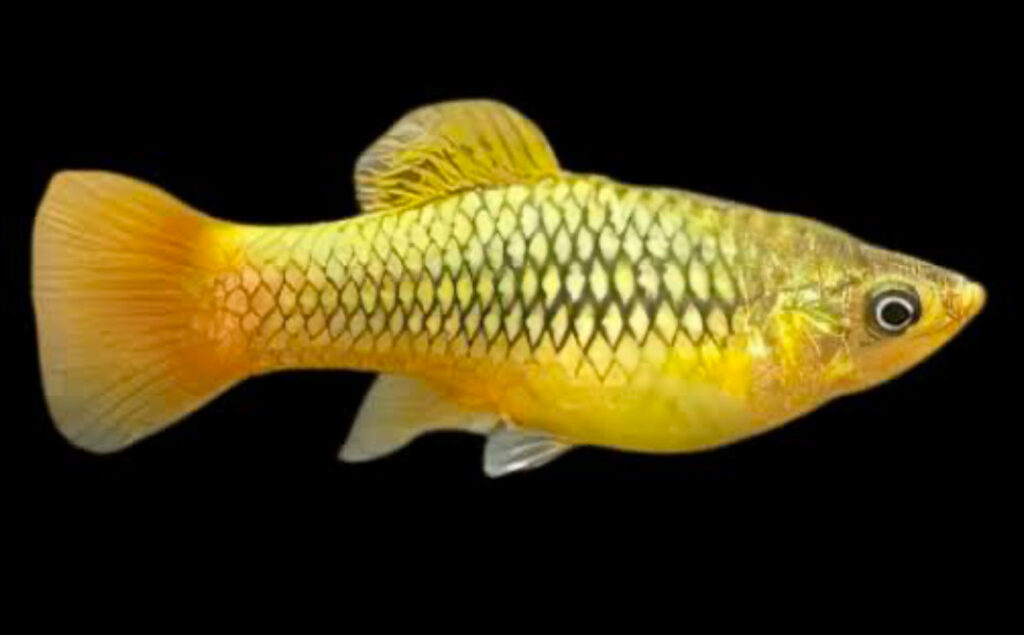
You can keep your tank looking rich and regal with a yellow aquarium fish. The Gold Platy fish is a worthy centerpiece because of its bright, vibrant hue, which reflects warm lighting. This golden freshwater fish, which looks like solid metallic gold, is hardy, active, and grows to 3 – 5 inches in maturity, making it ideal for nano aquariums.
Although the gold platy tolerates varying water conditions, it needs specific parameters to thrive.
Gold Platy Care Guide
To maintain this platy’s color morph, set the following water parameters:
- Temperature: 64 – 82°F
- pH: 7.0 – 8.2
- Hardness: 10 – 25 dGH
Also, feed them foods rich in carotenoids to keep their scales vibrant and protect them from fin-nippers or aggressive species. Compatible fish for gold platies include guppies, danios, and tetras.
Calico Platy Overview

The calico platy fish is a sub-variant of the coral platy that deserves attention. Its speckled pattern of orange, blue, black, and white is a visual dynamic that stands out in any tank.
Every individual variant of this spotted aquarium fish has a unique color mix, allowing you to have multiple calico Platies in one tank that look distinct.
Keep reading to see how you can care for this colorful beginner fish.
Calico Platy Care Guide
You can maintain this tri-color Platy in a private aquarium by providing at least 10 gallons of water for a single fish, with ample swimming space, filling the tank with dense vegetation, and setting standard platy water conditions.
- Temperature: 70 – 77°F
- pH: 7.0 – 8.4
- Hardiness: 10 – 20 dGH
Calico Platies eat plant and animal foods. They’re also livebearers in case you want to breed this variant.
Green Lantern Platy Overview

If you’re looking for a unique livebearer with a distinctive scale color, consider the Green Lantern Platy. It’s a freshwater fish with a deep green hue and an unforgettable iridescent shimmer to highlight darker substrates.
Unlike the other Platies in this guide so far, this green platy fish is suitable for intermediate to advanced hobbyists due to its more demanding care needs.
Green Lantern Platy Care Guide
This colorful aquarium fish is popular with collectors due to its appearance, but also because it possesses the skills to handle its intermediate care needs.
As a tiny fish, the green lantern variety is delicate and extra sensitive. They eat a lot of blanched vegetables with their live, frozen, or freeze-dried animal-based diet as well as flakes.
This variant also requires stable water conditions in a 10-gallon fish tank.
- Temperature: 72 – 82°F
- pH: 7.0 – 8.2
- Hardness: 10 – 28 dGH
Note that green lantern Platies prefer hard water, so you can add minerals to soft water to make it harder.
Hi-Fin Platy Overview

For exotic collectors who prefer ornamental aquarium fish, there are some fancy platy fish varieties, such as the Hi-Fin. It features an elegant, tall dorsal fin with a unique colorway of yellow, black, and red.
This fancy platy showcases its unique colors through active and showy swimming. It thrives in community tanks with moderate flow, where it can interact with other peaceful fish and glide gracefully in the water.
Hi-Fin Platy Care Guide
Get a 10-gallon tank for your single hi-fin platy and add interactive decor, as it loves exploring all levels of the tank.
The hi-fin, as one of the rarer platy varieties, requires hard water and stable conditions.
- Temperature: 70 – 82°F
- pH: 6.8 – 8.0
- Hardness: 10 – 25 dGH
Hi-fin Platies are jumpers, so add a secure but breathable lid to your tank’s structure to keep them from escaping.
Black Platy Overview

A dark aquarium fish with a sleek, solid color that contrasts against bright tankmates can also feel exotic.
The black platy fish is a perfect example of this variant. Its matte-black scales with tinted highlights make it the perfect, unique addition to an already colorful community tank.
Despite its dark and intimidating color, this jet black fish is peaceful, calm, and friendly.
Black Platy Care Guide
As a beginner livebearer, black Platies still need careful monitoring and attention to their environment and feeding.
They’ll eat omnivorous foods like every Platy and survive hardy water conditions.
- Temperature: 70 – 78°F
- pH: 6.8 – 7.5
- Hardness: 10 – 28 dGH
Dalmatian Platy Overview

Still on the topic of exotic and unique beginner aquarium fish, we have a striking spotted platy variant. The speckled black-and-white, or sometimes silver, playful Dalmatian platy fish comes in at number 12 on this list.
This hardy fish species brings its unique coloration and vibrant personality to livebearer tanks. Although it’s typically black and white, there are some rare red and black Dalmatian Platies.
Dalmatian Platy Care Guide
You can keep this spotted platy fish alone in a 10-gallon tank with rich live aquarium vegetation. They feed on high-quality commercial flakes supplemented with blanched vegetables and live foods, such as brine shrimp.
Set the following water parameters to make your Dalmatian platy comfortable:
- Temperature: 75 – 82°F
- pH: 7.0 – 8.5
- Hardness: 10 – 25 dGH
Variatus Platy Overview

Variatus platy fish is a hybrid variant bred from southern Platies and other popular collector favorites, such as the gold platy and sunset platy.
Due to its hybrid nature, the Variatus Platy is an unheated aquarium fish, as it thrives in a wider range of temperatures while maintaining the same hardiness as other variants in its genus. So, you can keep this variant in your low-tech aquarium setup without stressing about it being uncomfortable.
Variatus Platy Care Guide
As a hardy livebearer, the Variatus platy needs the following water conditions to survive:
- Temperature: 61 – 75°F
- pH: 7.0 – 8.0
- Hardiness: 8 – 20 dGH
That’s a wrap on the top 13 beginner fish types from the Platy species for your aquarium.
Conclusion: The Colorful Gateway Fish for Beginners
With so many types of platies listed in this guide, surely there’s one or two you can add to your collection.
As a species, platies are hardy and friendly, which makes them the ideal community tank starter fish, whether it’s for a species-only or diverse aquarium.
You can manage every beginner platy care tip, from providing adequate living conditions to feeding and selecting tank mates. This peaceful livebearer species offers endless color and personality for first-time aquarists. So, what more convincing do you need?

